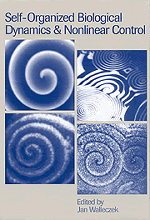 Self-Organized Biological Dynamics and Nonlinear Control
Self-Organized Biological Dynamics and Nonlinear Control Book contents
- Frontmatter
- Contents
- List of contributors
- Preface
- The frontiers and challenges of biodynamics research
- Part I Nonlinear dynamics in biology and response to stimuli
- Part II Nonlinear sensitivity of biological systems to electromagnetic stimuli
- Part III Stochastic noise-induced dynamics and transport in biological systems
- Part IV Nonlinear control of biological and other excitable systems
- Index
The frontiers and challenges of biodynamics research
Published online by Cambridge University Press: 14 August 2009
- Frontmatter
- Contents
- List of contributors
- Preface
- The frontiers and challenges of biodynamics research
- Part I Nonlinear dynamics in biology and response to stimuli
- Part II Nonlinear sensitivity of biological systems to electromagnetic stimuli
- Part III Stochastic noise-induced dynamics and transport in biological systems
- Part IV Nonlinear control of biological and other excitable systems
- Index
Summary
Background
As scientists unravel the secrets of the organization of life, an understanding of the temporal and spatiotemporal dynamics of biological processes is deemed crucial for creating a coherent, fully integrative picture of living organisms. In this endeavour, the basic challenge is to reveal how the coordinated, dynamical behavior of cells and tissues at the macroscopic level, emerges from the vast number of random molecular interactions at the microscopic level. This is the central task of modern biology and, traditionally, it has been tackled by focusing on the participating molecules and their microscopic properties, ultimately at the quantum level. Biologists often tacitly assume that once all the molecules have been identified, the complete functioning of the whole biological system can finally be derived from the sum of the individual molecular actions. This reductionistic approach has proven spectacularly successful in many areas of biological and medical research. As an example, the advances in molecular biology, which have led to the ability to manipulate DNA at the level of specific genes, will have a profound effect on the future course of medicine through the introduction of gene-based therapies. Despite this progress, however, the consensus is growing that the reductionist paradigm, by itself, may be too limiting for successfully dealing with fundamental questions such as (1) how living systems function as a whole, (2) how they transduce and process dynamical information, and (3) how they respond to external perturbations.
Information
- Type
- Chapter
- Information
- Self-Organized Biological Dynamics and Nonlinear ControlToward Understanding Complexity, Chaos and Emergent Function in Living Systems, pp. 1 - 12Publisher: Cambridge University PressPrint publication year: 2000
Accessibility standard: Unknown
Why this information is here
This section outlines the accessibility features of this content - including support for screen readers, full keyboard navigation and high-contrast display options. This may not be relevant for you.Accessibility Information
- 6
- Cited by